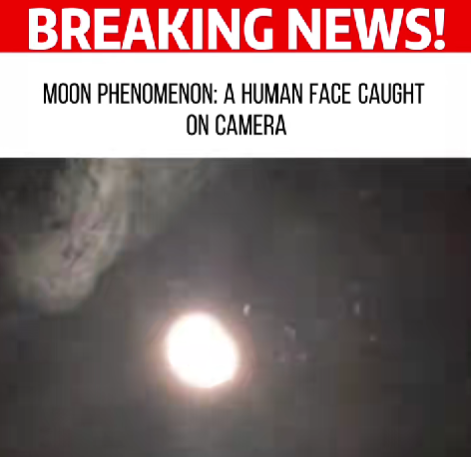A viral video showing what appears to be a human face forming on the surface of the moon has captivated millions online, with viewers around the world debating whether it’s a coincidence, a natural illusion, or something more extraordinary. The phenomenon, caught on a high-zoom camera, shows faint but recognizable facial features illuminated across the lunar surface, leaving many stunned and curious.
The footage, originally posted by an amateur astronomer, quickly spread across social media platforms where users claimed to see the outline of a face — complete with eyes, a nose, and even the impression of a mouth. “I couldn’t believe what I was seeing,” one viewer commented. “It was as if someone — or something — was looking back.”
While some internet users have dubbed it “The Face on the Moon,” experts say the sight has a far more grounded explanation. Astronomers describe it as a classic example of pareidolia — the human brain’s natural tendency to recognize familiar patterns, especially faces, in random shapes or textures. The same phenomenon explains why people often see animals in clouds or figures in tree bark.
Dr. Helen Vargas, a planetary scientist from the University of Cambridge, explained that lighting plays a key role in creating these illusions. “When sunlight strikes the moon at a low angle, craters and ridges cast long shadows,” she said. “Those shadows can easily form patterns that resemble eyes or a mouth — especially when seen through atmospheric distortion or imperfect lenses.”
Still, not everyone is convinced. Some online commentators argue that the video looks “too symmetrical” to be coincidence. Conspiracy theorists have suggested everything from hidden structures to ancient carvings on the moon’s surface, though NASA has repeatedly debunked claims of artificial formations.
In response to the viral clip, NASA issued a short statement reminding viewers that the moon’s surface is covered with millions of craters, ridges, and dust patterns — all of which can appear different depending on lighting conditions and the observer’s position. “The human imagination is powerful,” the agency noted. “Our brains are wired to seek familiarity, even where none exists.”
Despite the scientific explanations, the mysterious “face” has reignited fascination with lunar imagery. Social media users have been sharing their own moon photos, trying to capture similar shapes or symbols. Some even claim that the face appears to “move” or “change expression” as clouds pass by — though experts attribute that effect to shifting light and camera focus.
Whether seen as science or mystery, the event has united millions in awe and wonder. “It’s a reminder that the universe still has ways of surprising us,” one astronomy enthusiast wrote. “Even if it’s just light, shadow, and imagination — it’s still something magical.”
As debate continues, one thing is certain: the moon, humanity’s oldest cosmic companion, still holds the power to spark curiosity, creativity, and conversation — even in the age of modern science.
